The post Searching For Jaguars In Paraguay appeared first on The Expeditioner Travel Site.
]]>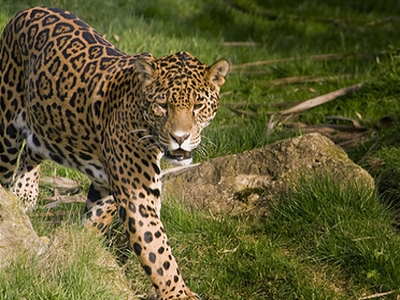
“Be Careful,” he shouted at me in clearly articulated Spanish as I began to walk towards the glowing green foliage of Cerro Cora National Park. “We’ve seen the jaguar out there three or four times already this month. It rained last night, so any prints you see will have been fresh.” As the park warden continued to ramble on about having enough water, sunscreen and bug spray, I nodded my head while pretending to listen. My ears, however, had heard the one word I both wanted and feared hearing: jaguar.
The Jaguar is among the most elusive animals in the world and, like many of the wild American cats, are stealth in their movements. They tend to stalk their targets in silence from tall grasses and thick brush while giving indication of their presence only through the footprints they leave behind in the Earth’s floor. Like a good mystery novel, the jaguar places both fear and intrigue into the minds of visitors. The sheer thought of their presence causes an overreaction in our body’s every sensation. It was that adrenaline flowing through my veins that stopped my heart, and everything it controls, when I heard the bone-chilling grumble shriek from behind me.
As I began my hike through this neglected national park in northern Paraguay, the mesmerizing intrigue of spotting an abundance of wildlife at first seemed to dominate my excited psyche. A wealth of odd-looking insects fluttered through the air and hopped along the dirt floor, and a wide range of birds flew through the air and settled down on the branches of trees looking down upon me in the same sort of curiosity as I stared up at them.
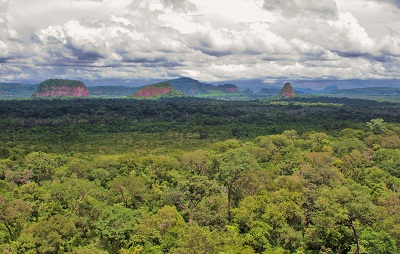 The scenery was far from unspectacular. A vast green ocean of dense tropical forest was interrupted only by tall pillars of bright red stone that jutted out randomly from the Earth’s crust. It is only from the view atop one of the nearby hills that the sheer size of the region can be fully appreciated. Thick red soil works as an anchor to tie in the range of flora that finds home in this remote park. It is amazing that such a large variety of life can exist in such a harsh climate; it is now 10 a.m. and already the thermometer has reached almost 100 degrees Fahrenheit.
The scenery was far from unspectacular. A vast green ocean of dense tropical forest was interrupted only by tall pillars of bright red stone that jutted out randomly from the Earth’s crust. It is only from the view atop one of the nearby hills that the sheer size of the region can be fully appreciated. Thick red soil works as an anchor to tie in the range of flora that finds home in this remote park. It is amazing that such a large variety of life can exist in such a harsh climate; it is now 10 a.m. and already the thermometer has reached almost 100 degrees Fahrenheit.
My hike through the park started with little entertainment beyond the occasional chase of a small green insect doing its best impression of a lost twig. My eyes panned the horizon searching for wildlife: jaguars, pumas, capybaras or even snakes. As I glanced down to the path ahead I realized that I was only a foot from a brightly colored snake that quickly slid off into the tall grass. The open path ahead was soon overtaken by tall yellow grass and thick shrubbery, and I couldn’t help but think what may lay in this overgrowth as my blind feet step through. My mood flipped from intrigued to terrified. My feet hopped through the tall brush one elongated step after another, moving slowly, hopefully enticing whatever may be sitting at the bottom to move rather than bite. My senses were now fully charged and the things that were once intriguing were now rattling my mood.
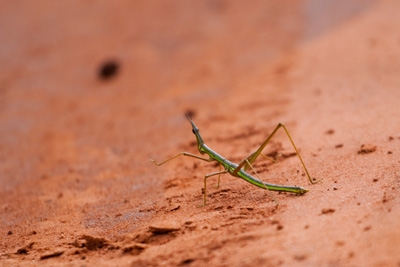 The colorful bugs playing in the bushes crackled a frightened sound as each one of the movements startled my peace. The circling vultures overhead began to press my worries as well. How long would it take for someone to find me out here in the middle of nowhere? When I signed the guest register I noticed that there had been only one other visitor to the park’s hiking trails over the past month, an American who visited two weeks ago.
The colorful bugs playing in the bushes crackled a frightened sound as each one of the movements startled my peace. The circling vultures overhead began to press my worries as well. How long would it take for someone to find me out here in the middle of nowhere? When I signed the guest register I noticed that there had been only one other visitor to the park’s hiking trails over the past month, an American who visited two weeks ago.
The park’s trail was as varied as the vegetation that surrounded it and the wildlife that inhabited it. One moment the path led downward into a hidden rainforest encapsulated by a canopy of tropical leaves. Later, the track climbed upward onto a flattened plateau that would be monotonous in its bland gray color if it were not for the bright red tail peaking through. It is here, I thought to myself, that the jaguar must find its home, hiding amongst the jagged edges of the 10-foot-high grasses.
My suspicions were reinforced as I came across a set of paw prints pressed into the soft soil of the trail. I wasn’t sure that they were jaguar, but what I did know was that they were big, and that they had been left by a cat that was moving in the same direction as I was — and they were fresh. I had hiked for two hours now and I could see my destination — a small hill with a lookout point — in the distance. I pulled my camera to my chest and told myself that the attached monopod could be used as a weapon should the situation arise.
I followed the tracks for 20 minutes while my neck worked overtime twisting my head on its swivel. Without a sight of a jaguar — my quest and my nemesis — I saw the fork I was warned of in the trail ahead of me. I diverted off to the left to climb the hill for the view I was promised. As I climbed the rudimentary path to the top, I was not disappointed with the reward I was left gazing at across the valley.
The vast, green tropical land flowed over the region while clouds casted shadows on the radiant colors saturated from the flora. Tall peaks formed statue-like mountains in the distance that seemed to look down on, and protect, the forest. As I sat down to enjoy my lunch in the comforting shade of a type of tree I had never seen before, I couldn’t help but wonder why so few people visit this natural paradise.
After lunch I began to make my way out of the park, in search of the highway I was told was about a 45-minute walk away. My excited feet scampered with a little more fervor than usual as I heard the breaking sound of a thundershower behind me in the not-too-far-off distance. As I rejoined the trail, I was once again confronted by the prints, and I again returned to following them without a choice.
My desperation grew a little bit stronger as I could sense the storm drawing closer behind me. I stopped to drink the last drops of water left in my plastic bottle. As I was screwing the lid back on, a fierce growl shrieked from behind me causing me to drop the lid. Upon recovery of my motor skills, I twisted my head in fear and intrigue. To my disappointment and content I saw a construction crew on the highway in the distance and a backhoe working at the pavement causing a scraping growl. I wandered up to the highway with a grin on my face and flagged down a bus to the next town.

About the Author
 Brendan van Son is a travel writer and photographer from Alberta, Canada. He has traveled to 6 of the 7 continents and shares his experiences through his variety of published articles and his website: Brendan’s Adventures: The World is my Jungle Gym.
Brendan van Son is a travel writer and photographer from Alberta, Canada. He has traveled to 6 of the 7 continents and shares his experiences through his variety of published articles and his website: Brendan’s Adventures: The World is my Jungle Gym.
[The Jaguar by Russell Hatherley/Flickr; Remaining photos by the Author]
The post Searching For Jaguars In Paraguay appeared first on The Expeditioner Travel Site.
]]>The post Choquequirao: The Other Machu Picchu? appeared first on The Expeditioner Travel Site.
]]>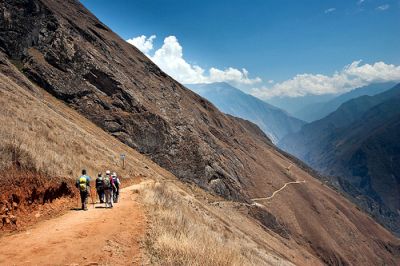
Not for the weary traveler, the multi-day trek to Choquequirao tests even the most experienced hikers. But what about the result? How about unforgettable Inca ruins far from the crowds of tourists at that “other” site.
The streets of the former Inca Capital, Cusco, Peru, are usually filled with tourists from around the world. They come in all forms, from backpackers, dressed in the South American backpacker’s uniform — flip-flops and Che Guevara beards — to the traditional tourist with their expensive cameras dangling from their necks and guidebook in hand. They are all looking to complete a pilgrimage to the Inca Mecca of Machu Picchu. However, when the Peruvian national government announced in February that Machu Picchu would be closed for several months, a good majority of visitors fled town, or canceled their trips all together.
It was then when the tourists were separated from the travelers. Tourists saw a missed opportunity, as the pictures they’d seen in magazines, and been so hoping to take with their own cameras, faded away. Travelers, on the other hand, saw an opening, a chance to experience something they, and most other people, otherwise would not have. As a local guide I spoke to put it, “there are hundreds of Machu Picchu’s located in the highlands of South America. It’s up to you to discover them.”
The “Inca Trail,” as advertised by the hoards of agencies promoting trekking to Machu Picchu, is, essentially, just a small section of a greater network of Inca Trails that web their way through the lushly covered mountains as far away as Colombia, and down to Northern Chile and Argentina. And Machu Picchu itself, although the crown jewel, is one of only hundreds, perhaps thousands, of ruins left behind by the Inca people. The trail to the site of Choquequirao is one of the less explored treks in Cusco’s Sacred Valley, and when the Inca Trail to Machu Picchu was closed, many travelers took the opportunity to follow this trail less traveled.
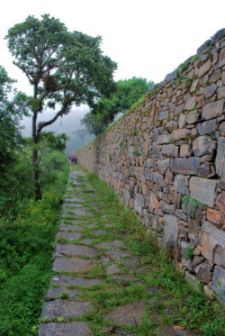 A round trip trek to Choquequirao can be done in either four or five days, depending on the fitness of the climber. There is also an option for hikers to turn the trek into a six-day hike; it continues from Choquequirao on to Machu Picchu. The trek isn’t without excitement. Just a few years ago, a couple local men spent their time hiding high above hikers and launching rocks down in an attempt to part them from their belongings. Local leaders, however, are said to have taken care of the problem, leaving the trail safe from theft. Nowadays, hikers are more likely to be approached by children from the local villages, dressed in traditional clothing and attempting to sell snacks.
A round trip trek to Choquequirao can be done in either four or five days, depending on the fitness of the climber. There is also an option for hikers to turn the trek into a six-day hike; it continues from Choquequirao on to Machu Picchu. The trek isn’t without excitement. Just a few years ago, a couple local men spent their time hiding high above hikers and launching rocks down in an attempt to part them from their belongings. Local leaders, however, are said to have taken care of the problem, leaving the trail safe from theft. Nowadays, hikers are more likely to be approached by children from the local villages, dressed in traditional clothing and attempting to sell snacks.
However, the threat of rocks being sent down from above is still a very real threat, especially during the rainy season, when rock and mud slides are a very common occurrence. Hikers are often left scurrying for shelter at the creaking sound of rocks breaking free from their respective landmass.
The Choquequirao trail is by no means easy; in fact, most of the local guides claim that it is twice as difficult as the Inca Trail to Machu Picchu. Unlike the Inca Trail, this path is not a highway paved in large, flat rocks. Rather, it is a dirt trail that, in the rainy season (December to March), is often reduced to a thick runway of calf-high mud. Although altitude isn’t too much of an issue along the trail, hikers are challenged by constant inclines and declines. Day two of the hike pushes climbers nearly 1,500m straight up, more than three times the height of the Empire State Building. This section can easily reduce the manliest lumberjack to tears.
The painful state that the relentless climb has reduced hikers to, however, is rewarded by entry into the site of Choquequirao. Much like Machu Picchu, Choquequirao is far from being the oldest Inca site. It is estimated that the site was constructed only about 400 to 500 years ago. Like the more famous site, the jungle has overtaken much of the site over the past couple of centuries. However, unlike Machu Picchu, this site has yet to be fully recovered and restored. It is estimated that only about 20-40 percent of the site has been uncovered.
What has been uncovered are thick walls of Inca stone, as well as managed, terraced land. It takes a nostalgic eye and imagination to try and understand what Choquequirao must have looked like during its days as a checkpoint for entrance into the Vilcabamba Valley. The wide, triangular walls must have, at one point, been covered by strategically laid thatched roofs, providing occupants refuge from the pounding tropical rains, and the smartly constructed terraces must have been covered at the time with crops of corn and a variety of fruits.
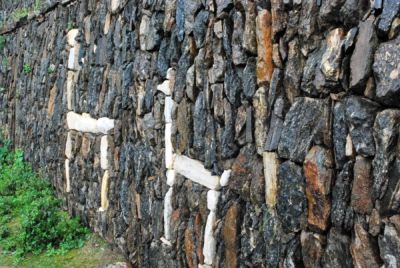 Perhaps the most impressive feature found within this Inca archaeological site is a set of terraces that have been enlaced with figures of llamas or alpacas. Regardless of the painfully hard work required to erect these large scale terraces, someone took the time to insert shapes of this animal using white rocks, a show of the large importance it held to these people at the time.
Perhaps the most impressive feature found within this Inca archaeological site is a set of terraces that have been enlaced with figures of llamas or alpacas. Regardless of the painfully hard work required to erect these large scale terraces, someone took the time to insert shapes of this animal using white rocks, a show of the large importance it held to these people at the time.
Although few places on earth can really compare to the mystique revealed to hikers as they cross under the sun gate and into the site of Machu Picchu, Choquequirao provides an intriguing destination that few people give themselves the opportunity to see. The difficult hike is as rewarding as any in the region, and in the future many more people may choose this as an alternative route in reaching Machu Picchu.
The most intriguing aspect of Choquequirao is its absolute rawness. Perhaps because a lack of interest, or maybe because of an influx of government funds into the more famous sites, Choquequirao remains largely uncovered. Unlike Machu Picchu, which by 9:00 a.m. is packed shoulder-to-shoulder with visitors, Choquequirao is nearly empty and free for visitors to enjoy in peace. The lack of train transport and the simple fact that it’s a difficult hike, should keep it this way for the near future. So as hikers retrace their steps down the knee-shattering, 1,500m descent, they can be satisfied in the knowledge that they have experienced something few others have. For the world’s true travelers, when one door shuts, or trail in this case, another one opens.
How To Get There:
Nearly all the trekking agencies in Cusco offer some sort of guided hike to Choquequirao. However, to be sure, you should book at least a couple of weeks in advance. One of the most reputable trekking agencies in Cusco is SAS travel (http://www.sastravelperu.com/). They have well-treated porters and great guides who will look after your every need. They include all your meals, which are top-notch, and provide snacks and water each day of the hike.
Machu Picchu Has Re-opened, What Now?
April marked the start of the dry season, as well the newly re-opened Inca Trail (and Machu Picchu itself). Jose at SAS Travel says that “the best time to visit (the area) is May and June.” According to this well-journeyed hiking guide, the area is still nice and green from the rainy season, dry enough that you will be able to enjoy the hike, and it is still be calm before the summer’s rush of tourists.
Of course the re-opening of the popular Inca Trail will mean that the number of treks to Choquequirao will likely drop significantly. However, this is still a great alternative to the Inca Trail. While a booking for the Inca Trail to Machu Picchu requires a booking at least three or four months in advance (and in some cases as many as eight months), during the spring/summer months a trek to Machu Picchu via Choquequirao can be booked only weeks in advance. The other great reason for hiking this trek is the lack of people on the trail. Unlike the Inca Trail you will never have to jostle for position with other hikers.

You can find Brendan’s blog at The World Is My Jungle Gym.
[Photos #2 and #3 by Nathan Foster]
The post Choquequirao: The Other Machu Picchu? appeared first on The Expeditioner Travel Site.
]]>